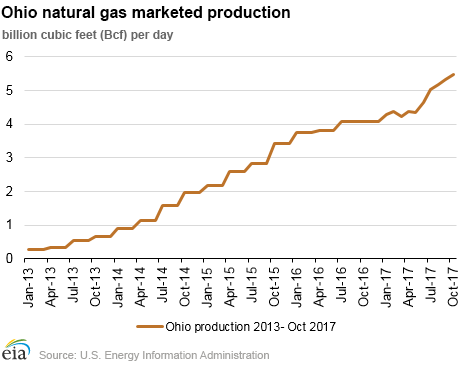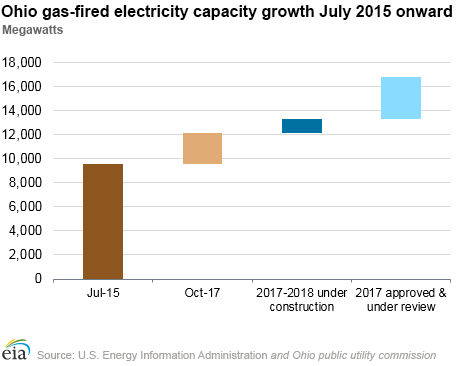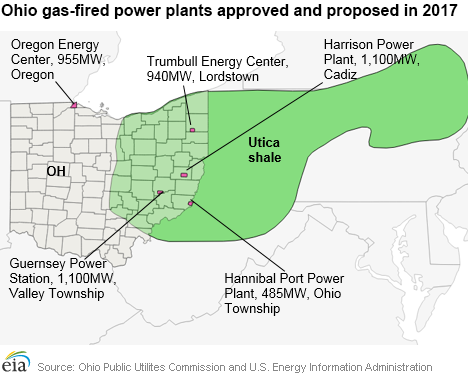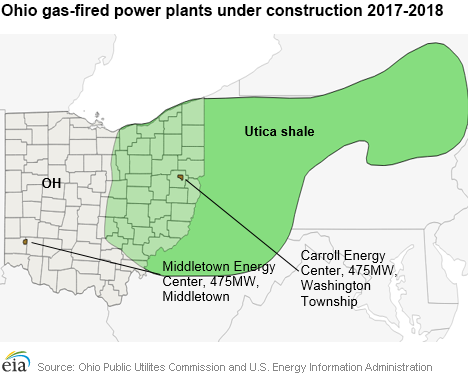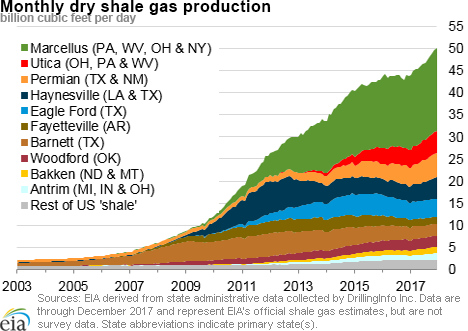In the News:
Record Ohio gas production spurs new natural gas processing and generation facilities
In October 2017, Ohio’s natural gas production reached a new high of 5.5 billion cubic feet per day (Bcf/d), doubling its May 2015 values. Most of Ohio’s natural gas production growth has come from the development of the Utica shale play, and Ohio currently represents 6% of total U.S. production. As the state’s natural gas production expands, Ohio’s natural gas processing capacity and natural gas-fired electric generation capacity have grown as well. With additional projects scheduled to come online in the coming years, growth in capacity for making use of Ohio’s natural gas and its products is expected to continue.
At the end of 2017, Ohio had about 4.2 Bcf/d of natural gas processing capacity, up from nearly 3.4 Bcf/d in 2014. According to data from IHS and Bentek Energy, two projects are schedule to come online in 2018 and will add an additional 0.4 Bcf/d to Ohio’s natural gas processing capacity. Both projects have capacities of 0.2 Bcf/d, one being developed by MarkWest Energy Partners and Energy and Minerals Group and the other being developed by Utica East Ohio Midstream LLC.
Currently, most of Ohio’s electricity is generated with coal and natural gas. As of October 2017, coal accounted for 16,273 megawatts (MW) (50%) of nameplate electric generation capacity in Ohio, while natural gas provided 12,121 MW (37%). From July 2015 through October 2017, 2,587 megawatts of natural gas generation capacity was added in the state. Two additional natural gas-fired combined cycle electricity generation plants are slated to enter service in 2018. Construction of the 700-MW Carroll County Energy Center was completed at the end of 2017 and is now undergoing startup and commissioning testing. NTE Energy is currently constructing the Middletown Energy Center, a 475-MW natural gas-fired electric generating facility in Middletown, Ohio, which is expected to start up in 2018.
Additionally, 3,480 MW natural gas-fired generation capacity has been approved by the Ohio Public Utilities Commission. These include:
- The 485-MW Hannibal Port Power project in Ohio Township, with a scheduled startup date in the second quarter of 2020, will be operated by Ohio River Partners, LLC
- The 955-MW Oregon Energy Center in Oregon, expecting commercial operation by summer 2020, will be operated by Clean Energy Future – Oregon, LLC
- The 940-MW Trumbull Energy Center in Lordstown, planning on commercial operation by summer 2020, will be operated by Clean Energy Future – Trumbull, LLC
- The 1,100-MW Guernsey plant in Valley Township, which is scheduled to start by third quarter 2020, will be operated by Guernsey Power Station, LLC
Another application filed by Harrison Power, LLC in September 2017 for the 1,100-MW Harrison Power Plant in Cadiz is still pending approval. If approved, the developers expect commercial operation for that project to begin in December 2021.
Overview:
(For the Week Ending Wednesday, January 24, 2018)
- Natural gas spot prices fell at most locations this report week (Wednesday, January 17 to Wednesday, January 24). The Henry Hub spot price fell from $3.87 per million British thermal units (MMBtu) last Wednesday to $3.56/MMBtu yesterday.
- At the New York Mercantile Exchange (Nymex), the February 2018 contract price rose 28¢ from $3.232/MMBtu last Wednesday to $3.509/MMBtu yesterday.
- Net withdrawals from working gas totaled 288 billion cubic feet (Bcf) for the week ending January 19. Working natural gas stocks are 2,296 Bcf, which is 18% lower than the year-ago level and 17% lower than the five-year (2013–17) average for this week.
- The natural gas plant liquids composite price at Mont Belvieu, Texas, fell by 5¢, averaging $7.98/MMBtu for the week ending January 24. The price of ethane, butane, and isobutane fell by 1%, 1%, and 3%, respectively. The price of natural gasoline and propane remained flat week over week.
- According to Baker Hughes, for the week ending Tuesday, January 16, the natural gas rig count increased by 2 to 189. The number of oil-directed rigs fell by 5 to 747. The total rig count decreased by 3, and it now stands at 936.
Prices/Supply/Demand:
Henry Hub price decreases with warmer week-over-week temperatures. This report week (Wednesday, January 17 to Wednesday, January 24), the national benchmark Henry Hub spot price fell 31¢ from $3.87/MMBtu last Wednesday to $3.56/MMBtu yesterday, the prices for delivery last Thursday and today, respectively. The average forecasted temperature for the Lower 48 states for today is 7 degrees Fahrenheit (ºF) higher than last Thursday’s average temperature. Also correlated to temperature trends, weekly average prices at the Henry Hub also decreased—from $3.91/MMBtu last week to $3.36/MMBtu this week—as the weekly average temperature across the Lower 48 states increased from 35ºF last report week to 40ºF this report week, based on data from National Oceanic and Atmospheric Administration (NOAA).
Key Midwest trading hub prices decrease. At the Chicago Citygate, prices decreased 5¢ from $3.32/MMBtu last Wednesday to $3.27/MMBtu yesterday, while delivery-day temperatures today in Illinois are expected to exceed last Thursday’s temperature by 15ºF. The weekly average price also decreased from $3.68/MMBtu last week to $3.04/MMBtu this week.
California price movements are mixed. The price at SoCal Citygate decreased 13¢ from $3.61/MMBtu last Wednesday to $3.48/MMBtu yesterday. Although demand in the region has been generally increasing from last report week to this report week, a series of pipeline maintenance and repair completions have increased Southern California Gas Company’s (SoCalGas) pipeline capacity through a key corridor (the Northern Zone). Maintenance work on a primary pipeline in the Northern Zone—Line 4000—was completed yesterday, according to SoCalGas, and the company is forecasting increased flows through the Northern Zone for the rest of the week.
Prices at PG&E Citygate in Northern California rose 3¢, up from $2.99/MMBtu last Wednesday to $3.02/MMBtu yesterday, while the average price for the week was unchanged from last report week to this report week.
Northeast price movements are mixed. At the Algonquin Citygate, which serves Boston-area consumers, prices went up $1.18 from $13.80/MMBtu last Wednesday to $14.98/MMBtu yesterday. Prices had been decreasing during the week—as temperatures in New England gradually rose—falling to a daily low of $3.11/MMBtu on January 22, 2018. However, with falling temperatures today, yesterday’s prices for today’s delivery ended at a weekly high of $14.98/MMBtu. Prices in New England tend to be higher than the national benchmark Henry Hub price in the winter, when demand is relatively high and regional pipeline system capacity constraints occur.
At the Transcontinental Pipeline Zone 6 trading point for New York, prices decreased $4.14 from $9.26/MMBtu last Wednesday to $5.12/MMBtu yesterday, while average prices for the week decreased $8.11 from $12.60/MMBtu last report week to $4.48/MMBtu this report week. Temperatures in New York City last report week had averaged in the teens on consecutive days, while temperatures in New York this week are, on average, 4 ºF higher than last week. Yesterday’s price of $5.12/MMBtu—for natural gas delivery today—was the high for the week, with temperatures today in New York expected to average 22ºF.
Appalachian prices decrease with warmer temperatures. Tennessee Zone 4 Marcellus spot prices decreased 32¢ from $2.87/MMBtu last Wednesday to $2.55/MMBtu yesterday, and average prices for the week decreased 42¢ from last report week to this report week. Prices at Dominion South in northwest Pennsylvania fell 14¢ from $2.92/MMBtu last Wednesday to $2.78/MMBtu yesterday, while the average price for the week decreased 41¢. Prices at both hubs continue to trade lower than the Henry Hub price.
Supply flat with domestic production offsetting imports from Canada. According to data from PointLogic Energy, the average total supply of natural gas remained the same as in the previous report week, averaging 83.0 Bcf/d. Dry natural gas production grew by 1% compared with the previous report week, a weekly average increase of 1 Bcf/d. Average net imports from Canada decreased by 8% from last week, from 6.5 Bcf/d to 6.0 Bcf/d.
Demand decreases. Total U.S. consumption of natural gas fell by 19% compared with the previous report week, according to data from PointLogic Energy, with national temperatures increasing from last week through this week. Natural gas consumed for power generation declined by 18% week over week. Temperatures in the southeastern United States—where heating by electricity is common—were higher than the freezing temperatures that occurred during the last report week. Industrial sector consumption decreased by 6% week over week. In the residential and commercial sectors, consumption declined by 25%. Natural gas exports to Mexico increased 1%.
U.S. liquefied natural gas (LNG) exports decrease week over week. Three LNG vessels (LNG-carrying capacity 11.5 Bcf combined) departed the Sabine Pass liquefaction facility last week (Thursday to Wednesday). Two tankers (LNG-carrying capacity 7.3 Bcf combined) were loading at the terminal on Wednesday.
Storage:
Working gas deficit to the five-year average grows by 124 Bcf. Net withdrawals from storage totaled 288 Bcf for the week ending January 19, compared with the five-year (2013–17) average net withdrawal of 164 Bcf and last year's net withdrawals of 137 Bcf during the same week. Working gas stocks total 2,296 Bcf, which is 486 Bcf less than the five-year average and 519 Bcf less than last year at this time. Working gas stocks are 59 Bcf less than the 5-year range for this period.
Withdrawals from storage totaled 1,036 Bcf during the last four report weeks. Total net withdrawals over the last four weeks top the previous four-week record of 980 Bcf, posted for the period between January 17 and February 14, 2014, during a polar vortex. This week’s withdrawal from storage of 288 Bcf tied the second-highest net withdrawal ever reported on the Weekly Natural Gas Storage Report (WNGSR). The two largest weekly net withdrawals in the history of the WNGSR have occurred in the last three weeks. If withdrawals from storage match the five-year average for the remainder of the heating season, which traditionally runs from October 31 to March 31, working gas stocks will total 1,216 Bcf, or 29% lower than the five-year average.
The February 2018 futures contract trades at a discount to the current spot price. During the most recent storage week, the average natural gas spot price at the Henry Hub was $4.09/MMBtu, 90¢/MMBtu higher than the front-month futures price at the Nymex. A year ago, the spot price was 7¢/MMBtu lower than the front-month contract. This pricing pattern provided economic incentives to withdraw natural gas from storage to avoid exposure to the spot market.
Reported withdrawals out of storage are near the upper end of analysts’ expectations, and prices on the Nymex increased following the release of the Weekly Natural Gas Storage Report. According to the Desk survey of natural gas analysts, estimates of the weekly net change in working natural gas storage ranged from 259 Bcf to 290 Bcf, with a median of 274 Bcf. Prices for the futures contract for February delivery, which is due to expire in trading on January 29, rose about 4¢/MMBtu, averaging $3.50/MMBtu, following the release of the Weekly Natural Gas Storage Report in light trading. Prices for the March contract gained about 1¢/MMBtu, averaging $3.12/MMBtu, with 836 contracts traded at the release. Prices varied and remained close to this level in subsequent trading.
Temperatures are lower than normal during the storage week, with significantly colder-than-normal temperatures in large parts of the midcontinent. Temperatures in the Lower 48 states averaged 30° F, 3° lower than the normal, 10° lower than last year at this time, and 4° colder on average since last week. Temperatures in the Midwest—where natural gas is consumed for space heating—averaged less than 16° F during the week, which was 7° to 9° lower than normal. The South Central region also posted below-normal temperatures, averaging 27° to 35°, or about 10° lower than normal, during the report week.
See also:
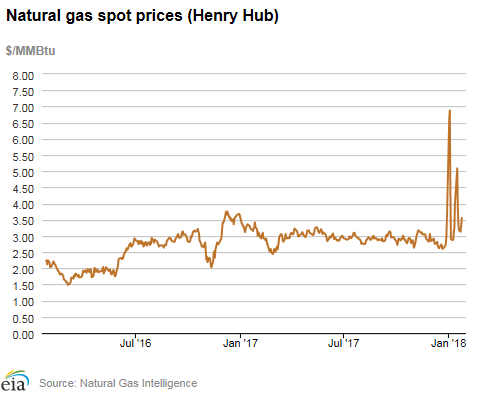
| Spot Prices ($/MMBtu) | Thu, 18-Jan |
Fri, 19-Jan |
Mon, 22-Jan |
Tue, 23-Jan |
Wed, 24-Jan |
|---|---|---|---|---|---|
| Henry Hub |
3.38 |
3.18 |
3.13 |
3.36 |
3.56 |
| New York |
4.45 |
3.40 |
3.13 |
3.71 |
5.12 |
| Chicago |
3.01 |
2.93 |
2.91 |
3.09 |
3.27 |
| Cal. Comp. Avg.* |
2.83 |
2.80 |
2.84 |
2.89 |
2.98 |
| Futures ($/MMBtu) | |||||
| January Contract | 3.189 |
3.185 |
3.224 |
3.444 |
3.509 |
| February Contract |
2.988 |
2.941 |
2.931 |
3.039 |
3.080 |
| *Avg. of NGI's reported prices for: Malin, PG&E Citygate, and Southern California Border Avg. | |||||
| Source: NGI's Daily Gas Price Index | |||||
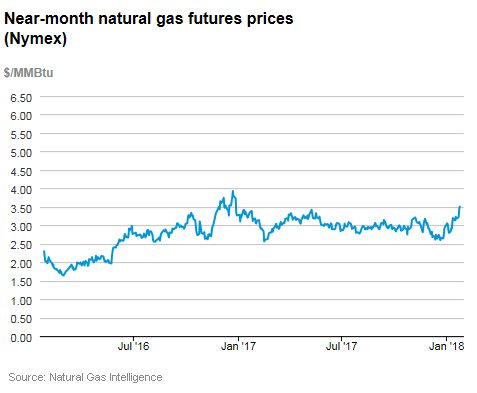
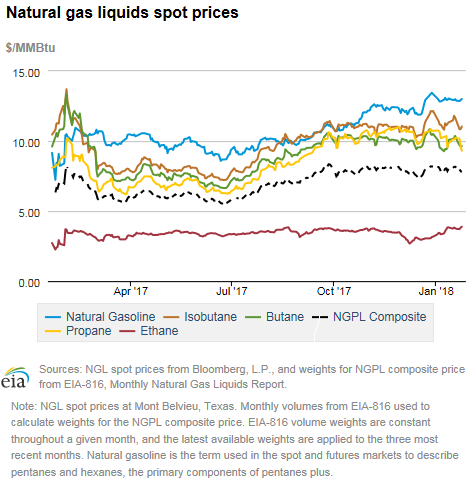
| U.S. natural gas supply - Gas Week: (1/18/18 - 1/24/18) | |||
|---|---|---|---|
Average daily values (Bcf/d): |
|||
this week |
last week |
last year |
|
| Marketed production | 86.0 |
85.0 |
78.7 |
| Dry production | 76.7 |
75.7 |
70.3 |
| Net Canada imports | 6.0 |
6.5 |
6.0 |
| LNG pipeline deliveries | 0.3 |
0.5 |
0.2 |
| Total supply | 83.0 |
82.7 |
76.5 |
|
Source: OPIS PointLogic Energy, an IHS Company | |||
| U.S. natural gas consumption - Gas Week: (1/18/18 - 1/24/18) | |||
|---|---|---|---|
Average daily values (Bcf/d): |
|||
this week |
last week |
last year |
|
| U.S. consumption | 83.6 |
102.7 |
72.2 |
| Power | 23.1 |
28.3 |
20.6 |
| Industrial | 22.8 |
24.3 |
21.6 |
| Residential/commercial | 37.7 |
50.1 |
29.9 |
| Mexico exports | 4.3 |
4.2 |
4.0 |
| Pipeline fuel use/losses | 6.5 |
8.0 |
5.6 |
| LNG pipeline receipts | 2.0 |
2.8 |
2.0 |
| Total demand | 96.4 |
117.8 |
83.8 |
|
Source: OPIS PointLogic Energy, an IHS Company | |||
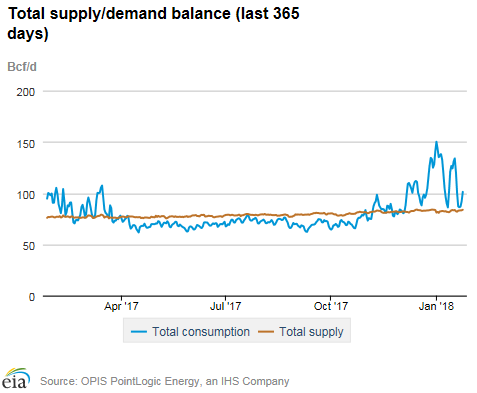
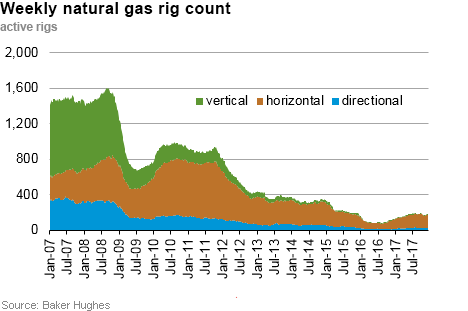
| Rigs | |||
|---|---|---|---|
Fri, January 19, 2018 |
Change from |
||
last week |
last year |
||
| Oil rigs | 747 |
-0.7% |
35.6% |
| Natural gas rigs | 189 |
1.1% |
33.1% |
| Note: Excludes any miscellaneous rigs | |||
| Rig numbers by type | |||
|---|---|---|---|
Fri, January 19, 2018 |
Change from |
||
last week |
last year |
||
| Vertical | 57 |
-8.1% |
-24.0% |
| Horizontal | 802 |
-0.4% |
43.5% |
| Directional | 77 |
6.9% |
28.3% |
| Source: Baker Hughes Inc. | |||
| Working gas in underground storage | ||||
|---|---|---|---|---|
Stocks billion cubic feet (Bcf) |
||||
| Region | 2018-01-19 |
2018-01-12 |
change |
|
| East | 555 |
614 |
-59 |
|
| Midwest | 634 |
717 |
-83 |
|
| Mountain | 145 |
158 |
-13 |
|
| Pacific | 233 |
244 |
-11 |
|
| South Central | 729 |
851 |
-122 |
|
| Total | 2,296 |
2,584 |
-288 |
|
| Source: U.S. Energy Information Administration | ||||
| Working gas in underground storage | |||||
|---|---|---|---|---|---|
Historical comparisons |
|||||
Year ago (1/19/17) |
5-year average (2013-2017) |
||||
| Region | Stocks (Bcf) |
% change |
Stocks (Bcf) |
% change |
|
| East | 602 |
-7.8 |
641 |
-13.4 |
|
| Midwest | 762 |
-16.8 |
734 |
-13.6 |
|
| Mountain | 174 |
-16.7 |
161 |
-9.9 |
|
| Pacific | 237 |
-1.7 |
261 |
-10.7 |
|
| South Central | 1,039 |
-29.8 |
985 |
-26.0 |
|
| Total | 2,815 |
-18.4 |
2,782 |
-17.5 |
|
| Source: U.S. Energy Information Administration | |||||
| Temperature – heating & cooling degree days (week ending Jan 18) | ||||||||
|---|---|---|---|---|---|---|---|---|
HDD deviation from: |
CDD deviation from: |
|||||||
| Region | HDD Current |
normal |
last year |
CDD Current |
normal |
last year |
||
| New England | 248 |
-27 |
30 |
0 |
0 |
0 |
||
| Middle Atlantic | 275 |
12 |
75 |
0 |
0 |
0 |
||
| E N Central | 345 |
48 |
111 |
0 |
0 |
0 |
||
| W N Central | 380 |
62 |
94 |
0 |
0 |
0 |
||
| South Atlantic | 208 |
24 |
120 |
3 |
-5 |
-9 |
||
| E S Central | 264 |
75 |
197 |
0 |
-2 |
-1 |
||
| W S Central | 213 |
72 |
146 |
0 |
-3 |
-10 |
||
| Mountain | 195 |
-39 |
-29 |
0 |
0 |
0 |
||
| Pacific | 65 |
-57 |
-76 |
0 |
-1 |
0 |
||
| United States | 244 |
18 |
67 |
1 |
-1 |
-3 |
||
|
Note: HDD = heating degree day; CDD = cooling degree day Source: National Oceanic and Atmospheric Administration | ||||||||
Average temperature (°F)
7-Day Mean ending Jan 18, 2018
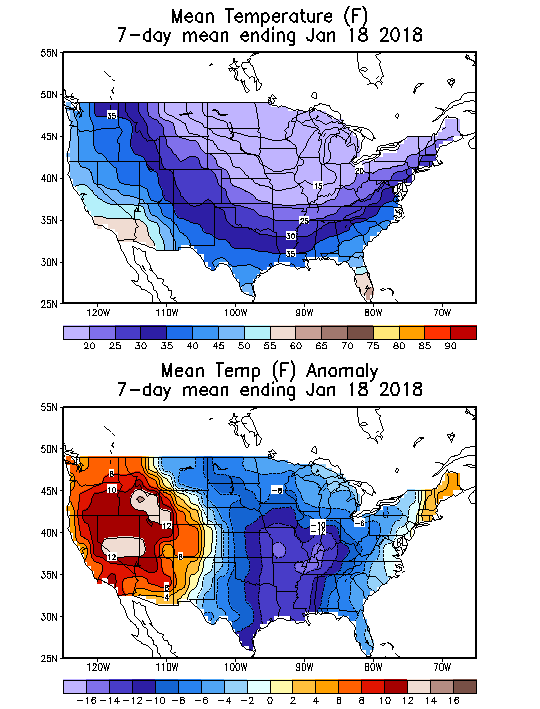
Source: NOAA National Weather Service
Deviation between average and normal (°F)
7-Day Mean ending Jan 18, 2018

Source: NOAA National Weather Service

